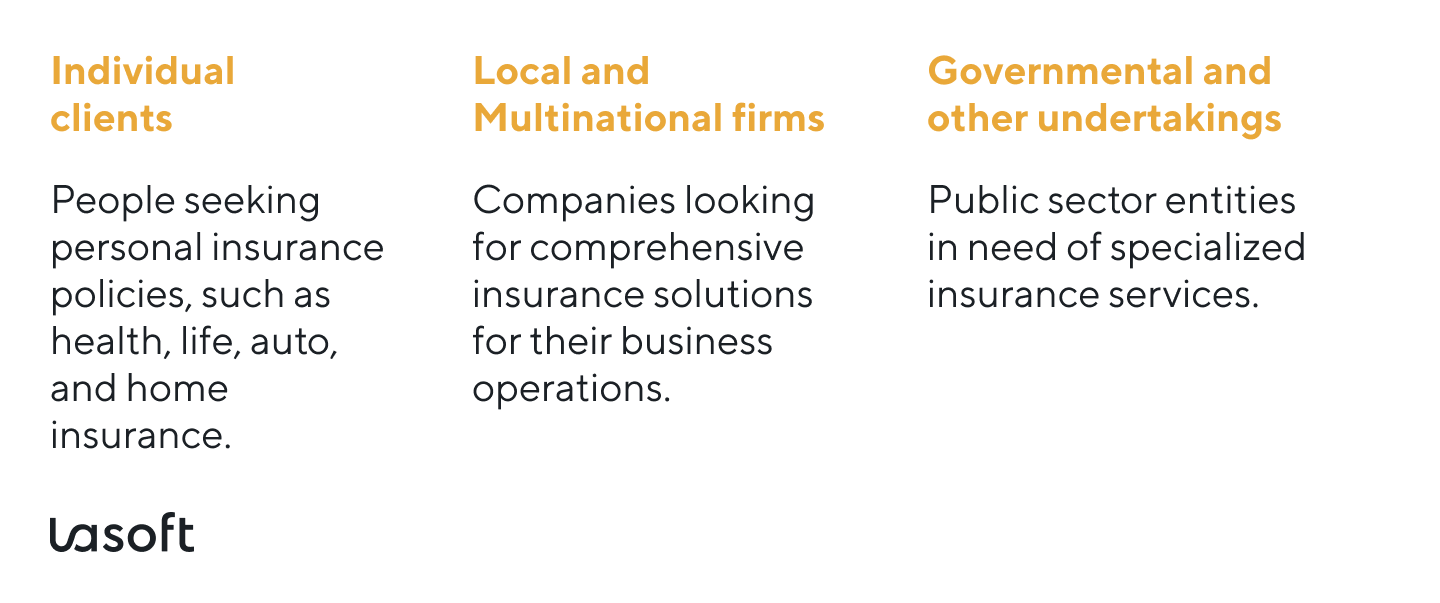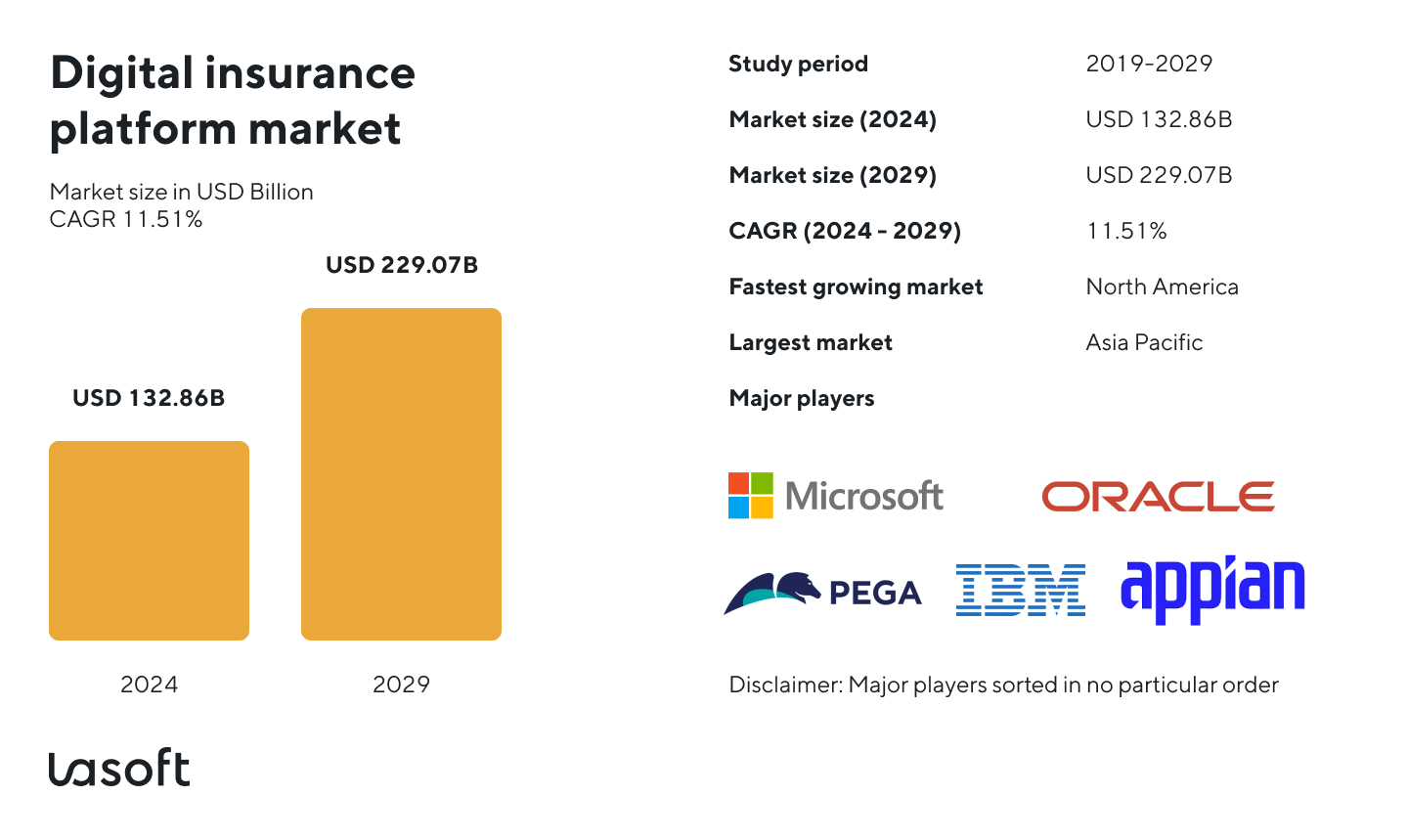Existential threats like catastrophic climate-related risks, cybercrime, and individuals without cover encourage insurers to rethink their approach to interactions with potential clients.
The insurance sector is eager to find the most effective ways to address the disruptions caused by these changing conditions and help clients prevent or mitigate risks rather than merely compensate for losses. That’s when advanced technologies help create insurtech products like insurance platforms or mobile applications, which enter the competitive market with unique insurance solutions.
We offer to learn from LaSoft’s experience how to build digital insurance platforms that work as comparison and recommendation systems for clients who need to have insurance all in one place despite being insured by more than one insurance company. Based on the data analyzed, the system recommends to the user the few most suitable offerings with the best price, with options to conclude and sign a contract and customer support on each stage of the process.
What is a Digital Insurance Platform?
A digital insurance platform is an online system that helps users manage their insurance policies, compare options, and receive recommendations based on their inquiries and needs. The platform simplifies the insurance process with integrated services, offering clients key features:
- Comparison and Recommendations System: Users can compare insurance policies and receive recommendations that meet their needs.
- Centralized Policy Management: Users can manage policies from multiple insurance providers in one digital insurance platform.
- Risk Assessment Tools are tools for assessing and managing risks. The platform can analyze the user’s data and compare it with the available policies to generate accurate estimates.
- Consultation Services: The digital platform can offer online insurance advisors and consultants access.
- User-Friendly Interface: Ensures intuitive navigation across the platform for users.
What is the Mission of Digital Insurance Platform?
Any insurance company’s leap to success is to provide services across the insurance spectrum. A competitive digital platform should cover risk management, insurance broking, agency, and underwriting in all classes of insurance, insurance advisers and consultants, pensions and investment advisers, consultant assessors, average adjusters, and mortgage brokers in all its branches.
The key mission of the insurance marketplace is to facilitate intermediaries with any person, firm, company, business, government, or another undertaking, including local and multinational firms operating in all sectors of the economy.
The platform should work as a comparison and recommendation system for clients who want to have it all in one place despite being insured by more than one insurance company. Based on several parameters and the type of insurance sought the system should recommend the few most suitable options to the user.

Why is Estimation Important in Software Projects?
Before the development phase of a new software project, the Lasoft team conducts thorough discovery and competitor research, defines functionality and features based on market tendencies, and offers our client an estimation of the digital insurance project. When our clients approve of the initial estimates, it turns into a budget. Spending more time on project discovery ultimately leads to a more accurate and reliable software project estimation.
Step 1: We compile a List of Tasks and Resources
The first step in project estimation is to develop a detailed list of tasks and identify the resources needed to complete them. Breaking the project down into manageable stages allows for a clearer assessment of time and cost, making it easier to assign tasks to a dedicated team.
Typical tasks might include research and planning, design, front-end and back-end development, content creation, testing, and launch preparation. Each project has its own unique list of tasks, but the goal remains the same: to ensure efficiency.
Step 2: Designing the Optimal Solution
An efficient project estimation process considers the size of the team required for the project. Capacity planning is essential to ensure the project progresses smoothly and stays on schedule.
Step 3: Creating a High-Level Architecture of the Solution
Accurate project cost estimation relies on a realistic approach. This step is crucial not only for the project’s overall success but also for maintaining the team’s efficient workflow.
Step 4: Estimating the Individual Components of the Solution
To ensure your digital insurance project remains financially feasible, it’s essential to accurately estimate costs by thoroughly analyzing the scope, schedule, and resources required. Understanding the financial implications is crucial before fully committing to a project.

Core Services We Implement Into Digital Insurance Platform Development
We then develop a comprehensive digital insurance platform with features catering to individual and corporate clients and providing a personalized, secure, and efficient user experience.
Any insurance company’s leap to success is to provide services across the insurance spectrum. A competitive digital platform should cover risk management, insurance broking, agency, and underwriting in all classes of insurance, insurance advisers and consultants, pensions and investment advisers, consultant assessors, average adjusters, and mortgage brokers in all its branches.
To make your digital project commercially successful, our development team offers the following features:
Insurance Calculator |
We can develop a platform with an insurance calculator that enables users to estimate insurance needs accurately. By entering various parameters, they get recommendations to get the best coverage options. We can also develop a mobile app that offers a convenient option to review policies and purchase them in a few minutes. |
Individual and Corporate Insurance |
Your platform may offer insurance products for both individual and corporate clients. It delivers customized options to meet diverse needs, such as personal life insurance or business risk management. |
Insurance Company Workspace |
We design and develop a dedicated workspace for insurance companies to facilitate efficient management systems, client interactions, and policy administration. |
Online Purchasing Service |
Insurtech platform should offer users an option to easily purchase insurance policies directly through the platform. As the secure and user-friendly online purchasing service ensures a hassle-free process, from selecting a policy to completing the payment. |
KYC Verification |
Digital insurance platforms should incorporate Know Your Customer (KYC) verification. This feature guarantees that user data is verified and secure, fostering trust and transparency. |
Document Management |
The platform can also have advanced document management capabilities to meet the complex needs of both insurance companies and their clients. This feature ensures that all documents, like policy agreements, claims, or client communications, can be automatically categorized, tagged, and stored.
We also ensure that the platform supports version control, allowing document updates to be tracked and previous versions to be preserved. It also integrates electronic signature (e-signature) capabilities, enabling clients and companies to sign documents digitally. |
Estimation Approach as a Part of Insurance Solutions
When you start building an insurtech platform or an application from scratch or simply add management features to a legacy system, you need to research what features and functionalities need your company, depending on the size of your business, and target audience in the market, its location, incomes and preferences. The Lasoft team, in turn, can offer an estimation of the project development budget. But to be specific, it’s possible to launch the MVP version starting at $40,000-$50,000 and to upgrade the service with additional features in the future.
Landing Page as a Lead Generation Tool For Startups and SMEs
A professionally designed landing page serves as an insurance company’s lead-generation tool. It unites potential clients and the insurer, making it essential to create an engaging experience. Often, digital insurance companies use it as a pilot project, as the next development task can be launching the insurance platform.
We advise conversion-focused design (UX) and SEO optimization to ensure the landing page attracts organic traffic and converts visitors into leads. This approach involves crafting compelling headlines, concise and persuasive copy, and clear calls to action (CTAs).
The LaSoft developers also integrate lead capture forms to gather essential client information for retargeting. Additionally, the page’s speed and mobile responsiveness are optimized to meet the highest standards, ensuring a seamless user experience across all devices. Some digital insurance companies choose a landing page to launch the product to the market, as the main advantage is that you cut your development time. You can also add an insurance calculator to the landing page so that your potential clients can get a final estimate online.
Insurance Company Workspace and Client’s Account
UX is a crucial development option that helps provide an intuitive workspace with an admin panel and customer profile. Whether it’s a large company or a startup, a thoughtfully designed workspace enables efficient management of policies, customer data, communications, and efficient claim processing.
LaSoft’s development approach focuses on security, user-friendly interfaces, and automation. We implement encryption protocols to protect sensitive customer data and ensure compliance with industry regulations.
When it comes to customer profiles, we emphasize easy access and transparency. Customers can easily log in to view their policies, make payments, and update their data. We also integrate features such as automatic notifications for policy renewals and payments to ensure customers are always informed and up to date.
Emailing Services
The emailing service we develop is designed for targeted communication. It enables companies to send messages to clients based on their specific needs and preferences: policy updates, payment reminders, or promotional offers. The system ensures the right message reaches the right client at the right time. The client’s account seamlessly integrates with the emailing service, allowing automated responses and follow-ups.
Estimation and Digital Options
Depending on the size of the project, its estimation in the discovery stage, and its final budget, we can design a digital insurance platform or landing page to offer either a single insurance option service or several insurance options service. The single one focuses on providing one specific type of insurance, such as auto or life insurance, optimizing the digital product for that particular product.
On the other hand, the platform can have several options that allow the management of multiple types of insurance products, offering a comprehensive system for clients seeking an online solution “all in one.”
Growing Demand For Coverage
Key drivers of the insurance market include digital transformation, a customer-centric approach, the widespread use of IoT for real-time data analytics, AI-driven fraud prevention, and the digitization of many processes in our lives.
The abundance of data and, therefore, the need for data privacy and protection and regulatory change also contribute to market growth. Insurtech solutions are applied in underwriting, claims processing, risk assessment, and fraud detection.
Insurtech adoption varies by region, with North America and Europe leading the market. A growing middle-class population in need of coverage is what is driving the Asia-Pacific region’s promising growth potential.
The global digital insurance platform market size is expected to expand at a compound annual growth rate (CAGR) of 11.51% from 2024 to 2029.

Source: Mordorintelligence
Insurtech in Emerging Markets
After establishing a strong presence of insurance companies in the U.S. and Europe over the past two decades, insurance is still an overlooked driver of economic growth in emerging markets. Startups and large corporations should take under consideration that many emerging countries still have a limited understanding of insurance products and their benefits. This lack of awareness leads to low demand for insurance, making it difficult for insurers to gain traction.
Also, experiences of poor offline service or unfulfilled claims lead to widespread distrust, and overcoming this skepticism is a significant challenge. Check out the diagram below to understand the share of insurtech funding transactions in different countries to understand the potential of insurtech in emerging markets.

Source: Statista
Low-income levels make traditional insurance products unaffordable for large segments of the population. While digital insurance aims to provide more affordable solutions, choosing the preferable rates and economic constraints still pose a significant challenge. However, due to a growing middle class, low insurance penetration rates, and high digital adoption, emerging markets are becoming a hotspot for insurtech and offer opportunities for insurers to grow.
Such markets face higher expense ratios than their European counterparts, revealing significant opportunities for digital platforms to support and enhance the current market players. Insurtech products can help to expand product offerings, digitalize customer interactions, develop new business models, and bridge inequality gaps. We offer some insights from LaSoft. We took a step back, reflecting on our experience in digital insurance platform development, and tried to see things from a different perspective.

Final Insights
LaSoft offers tailored development approaches for digital insurance platforms, designed to align with the client’s budget and timeline expectations or limitations. We develop solutions that not only cover immediate needs but also provide a clear ground for future growth. By creating a flexible MVP plan, we guarantee a quick, effective launch along with a thorough development roadmap that directs the ongoing evolution of your platform. Our development team is guided by a Project Manager, who ensures professional communication between client and team, helps you to make informed decisions in every stage, and there won’t be missed deadlines. Our goal is project success as we deliver scalable solutions that help you stay competitive in your niche.
FAQ
What is a Roadmap For Creating an Insurance Calculator?
Step 1: Define the Fundamentals
- Type of Insurance: Determine which type of insurance you are developing the calculator for (e.g., auto, health, life, home, investment, business).
- Parameters: Identify the variables needed to calculate the original estimate (e.g., age, location, property value, coverage level).
- Rules and Algorithms: Define the underwriting rules and mathematical formulas used to calculate final estimates.
Step 2: Design the User Interface
- Input Fields: Create fields where users can enter relevant information (e.g., age, type of insurance, policy term).
- UX: Ensure the calculator is easy to use, with clear instructions and a straightforward flow.
- Results Display: Design how the output will be displayed, including estimates, breakdown of costs, and explanations.
Step 3: Implement the Logic and Calculations
- Coding: Develop the algorithms to process user inputs and generate the results using Python, JavaScript, or C# programming languages.
- Integration: To enhance accuracy, integrate external data sources (e.g., databases for actuarial data APIs for real-time quotes).
- Testing: Run multiple test cases to ensure that the calculator’s estimates are accurate and align with industry standards.
Step 4: Incorporate Machine Learning (Optional)
- Implement machine learning models to analyze historical data and improve the accuracy of the estimates.
- Use predictive analytics to make analysis and identify common pitfalls, trends and patterns that can refine the estimation process.
Step 5: Final Effort
- Deployment: Deploy the calculator on web or mobile platforms, ensuring it’s optimized for different devices.
- Maintenance: Regularly update the software to accommodate insurance regulations, rates, and market conditions changes.
- Security: Implement security measures to protect user data and ensure compliance with data protection standards.
What Software Do Insurance Companies Use For Estimates?
APIs: Integration with third-party APIs for real-time data like actuarial databases, claims data, and customer profiles.
Data Storage: Store user inputs and calculation data in databases like MySQL, PostgreSQL, or NoSQL options like MongoDB.


